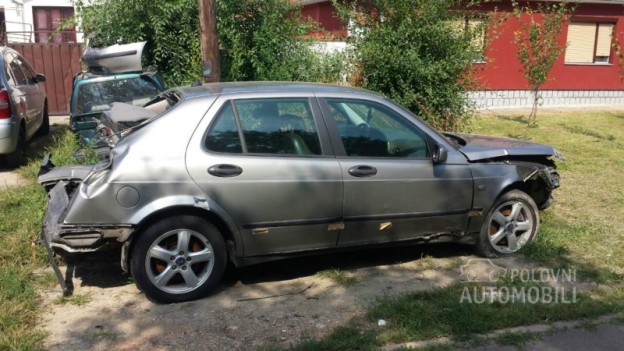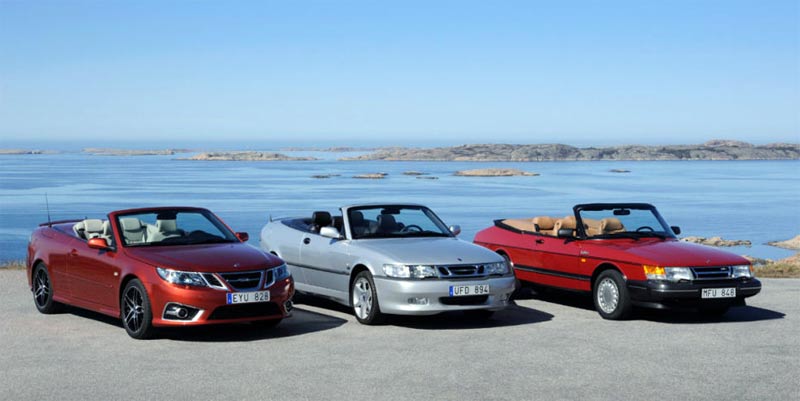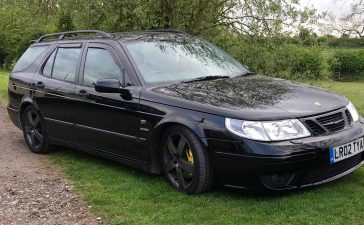This Saab 9-5 ended up somehow in sandwich… But it went well, the cabin was intact…
We now come to the more specific Saab traits which make it one of the few truly safe car brands on the road. Saab has always designed safe cars, but why exactly is one car safer than another? The answer lies in the way the safety cage is put together and the ways in which they are put to the test.
Good passive safety (body strength and design) stems from the ability to divert the large crash forces in a collision safely away from the occupants, preventing crush injuries as well as impact force injuries.

The physics of decelerating the human body in such a way as not to cause injury is the ultimate aim of any car safety strategy, the idea being to slow the forward momentum of a person at a rate whereby no internal injuries occur.
This is separate to preventing the crushing of the passenger cell where external injuries occur by physically compressing the space a person occupies, causing the crushing of body parts as a result. Of course, both these concepts come together in a crash, to hopefully allow a person to open their door after a crash and be able to walk away, as opposed to being trapped in a crushed body shell with internal injuries.
Saab’s safety design begins with the bumpers, which are built to absorb impacts of up to 8kmh with no damage. The bumper is constructed of foam with a heavy steel backing, as opposed to most cars which are merely a plastic clip on affair with no structural strength whatsoever. This is also the first stage of the larger crash picture, because it assists in spreading offset collision forces over a greater area, thereby lessening the impact on the passenger compartment.
The next level of crash protection is up to about 20kmh, where specially designed structural members are designed to absorb the impact, saving the rest of the structure from damage and limiting repair costs. Up to this stage, the occupants are unlikely to injured, due to the small forces involved. Indeed, at this speed the Saab’s airbags have not even deployed (they are designed to deploy above 25kmh in conjunction with the seat belt pre-tensioners, covered later on).
Above about 25kmh, it becomes necessary to disperse the crash forces away from the passenger cell, and to limit the deceleration forces on the occupants. Up to about 60kmh, this is largely done by creating special structural members in the front and back of the car to crumple in a pre-determined way to absorb energy and not compress the passenger cell. It also becomes necessary at this speed to ensure that no engine parts or other items penetrate the passenger cell either. This means that in a Saab the engine is designed to slide under the passenger compartment rather than through it in a severe frontal crash.
Equally, the rear is protected by similar structural members to divert forces away from the passenger cell, an area often neglected by most manufacturers. As most frontal accidents occur off the centreline of the car, Saabs are further optimised to evenly distribute the forces resulting from an offset collision, such as having strengthened front door sills to prevent the wheel from intruding, as well as structural members which take the impact force and spread it over the whole front end, not concentrating it on one side.
Side impacts account for about 40% of all collisions, and as such Saab have developed an excellent side impact system which diverts forces away from the passenger cell, as well as minimising the amount of side deformation to it. To this end there are many lateral cross-members, including the brilliant Saab Safeseat, specially strengthened pillars and very strong doors with side intrusion beams and interior padding. Also, the doors have been designed with a full overlap area, ie. they overlap the car structure in all places to prevent the door moving inwards from any angle.
This type of door is a prerequisite for good side safety, as it can withstand much more side force without buckling and entering the passenger compartment. The windows also retract fully, as opposed to several modern cars such as Subaru and Mitsubishi where the window doesn’t, but rather sits three quarters down, but worse still with the corner at an angle to the sill! This is a ludicrous design, as a side impact is likely to impale the rear passengers on a nice sharp piece of window, most likely killing them by decapitation or severe brain trauma. On the subject of windows, a general tip is to wind them down completely, or only down by a couple of centimetres, preventing your temple from impacting with an edged surface if it were half way down.











